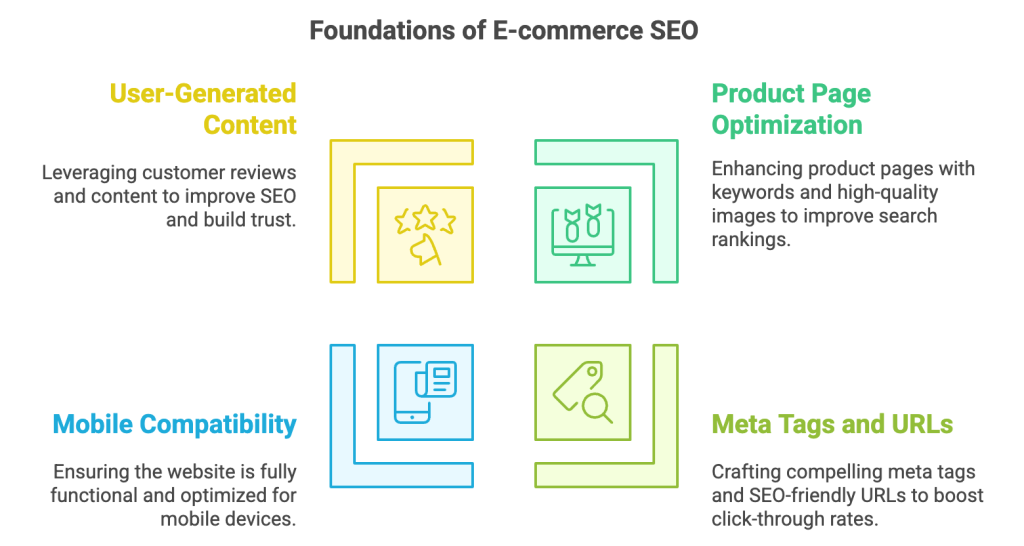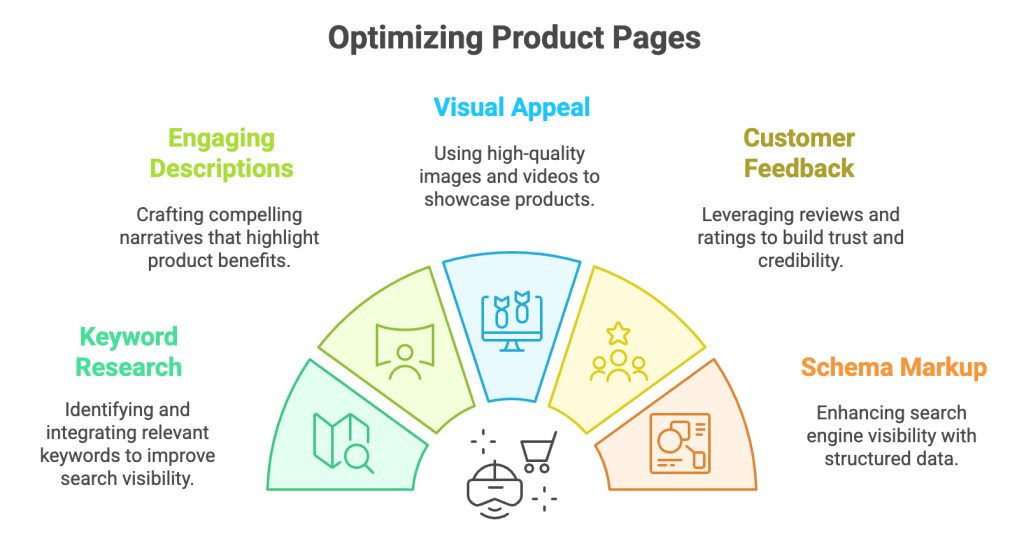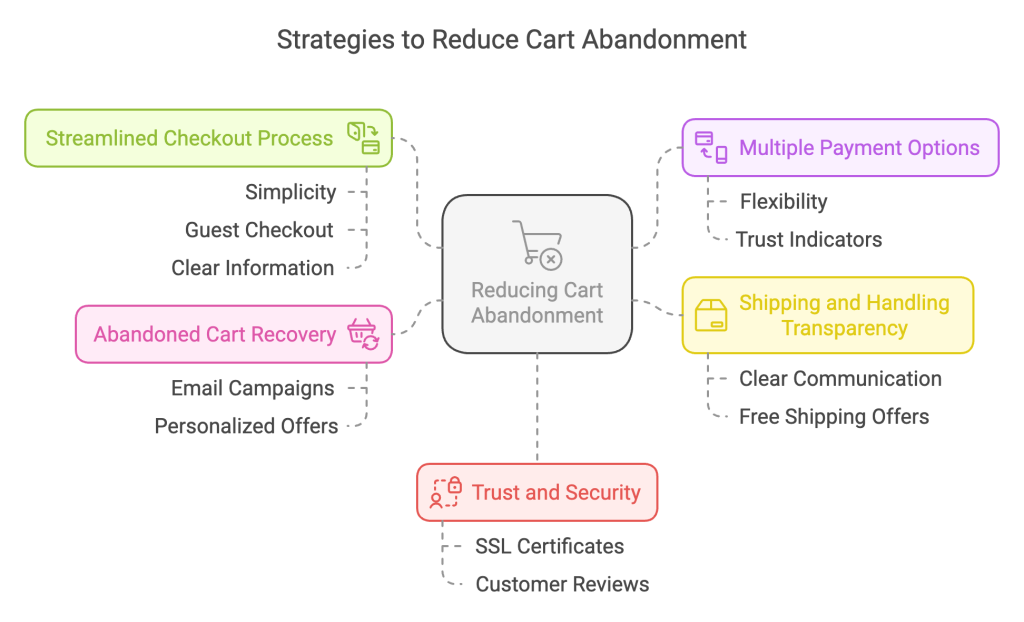E-commerce SEO is crucial for a successful online store. By optimizing product pages and categories, you can improve visibility in search engine results, attract more organic traffic, and increase conversions. Effective e-commerce SEO starts with thorough keyword research to identify terms potential customers use. Long-tail, more specific, and less competitive keywords can drive targeted traffic. Analyzing competitors’ keywords also provides valuable insights.
On-page optimization is vital, involving the enhancement of product titles, descriptions, and images with relevant keywords. Each product page should have a unique meta title and description to attract clicks from search engine results pages (SERPs). High-quality images with descriptive alt text improve the chances of ranking in image search results. Structured data markup can enhance listings by directly displaying SERPs’ rich snippets, such as product reviews and ratings.
Site structure and technical SEO are also essential. A well-organized site with clear navigation makes it easier for search engines to crawl and index pages. Creating an XML sitemap and ensuring mobile-friendliness and site speed are crucial for performance. Content marketing can drive organic traffic and improve authority by creating valuable content like blog posts and buying guides. Link building through reputable websites boosts site authority and ranking potential.
Monitoring your SEO performance with tools like Google Analytics and Search Console is crucial. Reviewing metrics such as organic traffic and conversions helps you adjust your strategy for better results. This proactive approach boosts your online store’s visibility, attracts more visitors from search engines, and increases sales, ensuring your e-commerce business thrives in the long run.
Exploring The Significance Of E-commerce SEO
Understanding e-commerce SEO is essential for any online business aiming to succeed in today’s digital marketplace. Customers rely on search engines to guide their purchasing decisions when searching for products online. According to a survey, 87% of shoppers begin product searches online, underscoring the importance of SEO in driving e-commerce success.
Hiring an expert e-commerce SEO services provider is crucial for ensuring your online store is fully optimized to compete in the digital marketplace, driving targeted traffic and increasing conversion rates.
Key Elements Of E-commerce SEO
Product Pages and Categories
Businesses can enhance their visibility in search engine results pages (SERPs) for relevant keywords by strategically optimizing product pages and categories. This optimization increases organic traffic to the website and improves click-through rates, ultimately leading to higher conversion rates from visitors to paying customers.
Optimizing product pages involves more than just inserting keywords. It includes optimizing product descriptions, images, and meta tags to align with customer search intents. According to Backlinko, properly optimized product descriptions that are unique, detailed, and keyword-rich can significantly improve a page’s search engine ranking. High-quality images with appropriate alt texts and descriptive filenames can enhance SEO performance.
Meta Tags and SEO-friendly URLs
Meta tags, including title tags and meta descriptions, are crucial for e-commerce SEO. They provide search engines and users with a summary of the page content. Moz highlights that a compelling and keyword-optimized title tag can improve click-through rates from search engine results pages.
Creating SEO-friendly URLs is another critical factor. URLs should be short, descriptive, and include target keywords. According to Neil Patel, a well-structured URL can enhance user experience and search engine readability, contributing to better search engine rankings.

Mobile Compatibility
Ensuring mobile compatibility is vital as more consumers shop via mobile devices. Google’s Mobile-First Indexing means that the mobile version of a site is considered the primary version for ranking purposes. Research from Statista shows that over 54% of global website traffic comes from mobile devices, making mobile optimization a crucial aspect of e-commerce SEO.
Also Read: Mobile eCommerce Statistics and Trends 2024
User-Generated Content And Reviews
User-generated content and reviews significantly enhance SEO by providing new, relevant content that search engines prioritize. A study by BrightLocal found that 91% of consumers read online reviews before purchasing. Including these reviews on your product pages improves SEO and builds customer trust, leading to higher conversion rates.
E-commerce SEO requires strategically placing your products in front of the right audience at the right time. By optimizing your website and content to align with customer searches, you attract more visitors, convert them into loyal customers, and increase sales. This approach fosters steady growth and higher profits for your online business.
E-commerce SEO demands meticulous attention to various aspects of your online store. Optimizing product page meta tags, ensuring mobile compatibility, and leveraging user-generated content are all crucial for improving site visibility and driving sales. Implementing these strategies ensures your e-commerce business meets and exceeds its growth and profitability goals.
Product Page Optimization: The Foundation of E-commerce Success
Product pages serve as digital storefronts where customers decide on purchases. Enhancing these pages for search engines and user experience is crucial for boosting sales. Effective optimization includes crafting compelling titles and descriptions with relevant keywords for improved search rankings.
User experience enhancements like high-quality images, detailed specifications, customer reviews, and intuitive navigation are essential for building buyer confidence and increasing conversions. By combining SEO strategies with user-centric design, businesses can maximize the effectiveness of their product pages as powerful tools in driving sales and maintaining a competitive edge in the online marketplace.

Here are some cornerstone principles to consider for product page optimization:
Keyword Research And Integration
- Conduct thorough keyword research: Use tools like Google Keyword Planner, SEMrush, or Ahrefs to conduct comprehensive keyword research. Identify relevant keywords and phrases that potential customers use when searching for products similar to yours. Understanding these search trends helps craft an effective SEO strategy.
- Integrate keywords strategically: Incorporate the identified keywords naturally into your product titles, descriptions, meta tags, and image alt text. This strategic integration optimizes your visibility in search engine results. Avoid keyword stuffing, which can harm your search engine rankings and diminish user experience.
- Target long-tail keywords: Focus on long-tail keywords specific to your products or services. While these keywords may have lower search volumes than broader terms, they often lead to higher conversion rates. Long-tail keywords also help you attract more qualified traffic that is closer to making a purchasing decision.
Engaging Product Descriptions
- Informative and Engaging: Ensure that the product description offers in-depth details about the product’s features, benefits, and specifications. Use straightforward and succinct language to facilitate easy understanding and informed decision-making.
- Storytelling: Create a compelling narrative that showcases the product’s distinctive features and illustrates how these features solve specific customer challenges. Weave a story around the product, highlight its unique selling points, and demonstrate its practical applications in real-life scenarios.
- Customer Focus: Anticipate and address potential questions or concerns that prospective customers may have about the product directly within the product description. This approach builds credibility and confidence in potential buyers, ultimately encouraging them to purchase.
High-Quality Product Images And Videos
- Improve Your Visual Presentation: Enhance your website’s appeal with high-quality product images featuring consistent backgrounds. These images capture potential customers’ attention and provide them with clear, detailed visuals that showcase the exceptional quality of your products.
- Showcase Your Product Benefits: Engage your audience effectively through compelling videos highlighting your products’ unique features and practical advantages. This approach helps customers see the real value in your offer, potentially boosting your sales.
- Make Your Images Work Better: Optimize your website’s performance by reducing the size of image files, using descriptive filenames, and adding relevant alt text. This optimization speeds up your site, improves its visibility in search engines, and enhances the overall user experience.
Customer Feedback And Ratings
- Prominent Reviews Influence: Positive reviews are critical in influencing purchasing decisions. According to Nielsen, 92% of consumers trust user-generated content more than traditional advertising. Highlighting authentic customer experiences prominently on product pages enhances credibility and significantly boosts sales by providing valuable social proof.
- Clear Instructions for Reviews: Streamlining the process of sharing feedback is essential. Research from BrightLocal indicates that 68% of consumers are more likely to leave reviews if prompted. Implementing automated follow-up emails with clear review prompts or offering incentives like discounts encourages customers to share their experiences, enriching feedback quality.
- Professional Review Responses: Responding promptly and professionally to reviews is crucial for maintaining customer satisfaction and trust. Harvard Business Review reveals that businesses that engage with reviews are perceived as 1.7 times more trustworthy. Addressing feedback promptly and positively resolves issues and demonstrates responsiveness and commitment to customer care, enhancing brand reputation.
Enhancing Product Visibility With Schema Markup
This approach provides search engines with structured data detailing information about your products, potentially leading to the display of rich snippets in search results. Consequently, this can significantly enhance click-through rates by making your listings more informative and appealing to users searching for relevant products. Proper implementation ensures that your products stand out with clear, concise information that meets search engine criteria for enhanced visibility.
Also Read: eCommerce Technical SEO Audit: A Step-by-Step Guide
Category Optimization: Navigating Your Product Landscape
Category pages are like the map of your online store. They help customers easily find what they’re looking for. Making these pages better means people can move around your store smoothly and find products they want quickly.
A well-organized category page also makes shopping more enjoyable. It shows products neatly, making customers more likely to buy something. Plus, when you improve these pages for search engines, more people can find your products online. This can bring in more visitors who might become customers. Spending time to make your category pages better is significant. It makes customers happier and can help your business grow online.

Here are some effective strategies for category optimization:
Concise and Informative Category Titles
- Keyword-Rich: Targeting relevant keywords that users search for is essential. Use long-tail keywords to describe specific product categories, such as “Luxury Running Shoes for Women” instead of “Shoes.” Employ keyword research tools like Google Keyword Planner, Ahrefs, or SEMrush to identify search trends and niche opportunities. Long-tail keywords usually have lower competition and higher conversion rates as they attract more targeted traffic.
- User-Friendly: Maintain clarity and avoid technical jargon. Opt for simple, straightforward language that your target audience can easily understand. Ensuring your content is accessible and easily digestible improves user experience and engagement, ultimately leading to better SEO performance.
- A/B Testing: Consider running A/B tests with different category name variations to see which resonates best with your audience. Tools like Google Optimize or Optimizely can help you test headlines, descriptions, and keywords to determine which combinations yield the highest engagement and conversion rates.
Informative Category Descriptions
- Keyword Optimization: Strategically incorporate relevant keywords but prioritize user experience over keyword stuffing. Ensure that your content flows naturally and that keywords are integrated seamlessly. Overloading your content with keywords can harm readability and user experience and lead to penalties from search engines.
- Product Benefits: Showcase the key advantages and solutions your products offer. Highlight what makes them unique and how they address customer needs. Use bullet points or concise paragraphs to make this information accessible to scan. For instance, instead of just listing features, explain how those features translate into benefits for the user.
- Call to Action (CTA): Prompt visitors to delve deeper into the category. Use strong verbs and clear language, such as “Shop Now,” “Explore Our Collection,” or “Learn More.” Effective CTAs guide users through your site and encourage them to take the desired action, whether purchasing, signing up for a newsletter, or exploring more content.
- Content Integration: To provide valuable content and improve engagement, consider including short, informative blog posts or buying guides within the category page. Content like “How to Choose the Perfect Running Shoes” or “Top Trends in Women’s Luxury Footwear” can provide additional value to visitors, keeping them on your site longer and enhancing their shopping experience.
Internal Linking
- Relevant Connections: Establish a web of links within your site. Link to related products, subcategories, and informative blog posts relevant to the category. This improves user experience and encourages exploration. Internal linking also helps distribute page authority throughout your site, boosting SEO.
- Information Architecture: Create a logical site structure with a clear hierarchy. This ensures users can easily navigate the products they seek and helps search engines understand your website’s content organization. A well-structured site improves user experience and SEO, making it easier for visitors and search engines to find and index your content.
- Breadcrumbs: Implement breadcrumbs to show users their current location within the website’s hierarchy and provide a clear path to higher-level categories. Breadcrumbs improve navigation and reduce bounce rates by helping users understand the structure of your site and quickly return to previously visited pages.
Reducing Cart Abandonment: Maximizing Conversions
Cart abandonment is a prevalent challenge in e-commerce. Implementing effective strategies to minimize it is crucial for boosting sales and revenue.

Streamlined Checkout Process
- Simplicity: The checkout process should be streamlined and intuitive, minimizing the number of steps required to purchase.
- Guest Checkout: Offering a guest checkout option allows customers to make purchases without creating an account, reducing friction and encouraging impulse buys.
- Clear and Concise Information: Only request essential information from customers, such as shipping address and payment details, to expedite checkout.
Multiple Payment Options
- Flexibility: Providing a range of secure payment methods, including credit cards, digital wallets (e.g., PayPal, Apple Pay), and buy now, pay later options like Afterpay, accommodates diverse customer preferences.
- Trust Indicators: Displaying trust badges, such as SSL certificates and recognized payment icons (e.g., Visa, Mastercard), enhances security perceptions and encourages trust.
Shipping and Handling Transparency
- Clear Communication: Communicate shipping costs, delivery times, and return policies upfront during the checkout process to manage customer expectations and reduce surprises.
- Free Shipping Offers: Consider implementing free shipping thresholds or promotional periods to incentivize larger purchases and reduce cart abandonment rates.
Abandoned Cart Recovery
- Email Campaigns: Implement automated email sequences to remind customers about items left in their carts and provide a direct link to complete their purchase.
- Personalized Offers: To entice customers back to complete their transactions, tailor email reminders with personalized recommendations or discounts on abandoned items.
Trust and Security
- SSL Certificates: Ensure your website is secured with SSL certificates to encrypt customer data and protect against data breaches, thereby fostering trust.
- Customer Reviews: Promising authentic customer reviews and testimonials on your site can enhance credibility and reassure hesitant buyers.
By integrating these strategies, e-commerce businesses can reduce cart abandonment rates, enhance customer satisfaction, and drive higher sales conversions.
Advanced E-commerce SEO Techniques
Consider implementing these winning ecommerce SEO strategies to enhance your competitive advantage.

Mobile Optimization
- Responsive Design: Ensure your website is fully responsive and optimized for mobile devices to provide an optimal viewing and interaction experience across various devices, from desktop computers to smartphones and tablets. This involves using fluid grids and flexible layouts that adjust smoothly to different screen sizes and orientations.
- Mobile-Friendly Content: Create tailored content for mobile users to enhance readability and usability. This includes concise and scannable text, larger fonts, and touch-friendly navigation. Optimizing images and videos for quick loading on mobile devices can also improve the overall user experience.
Local SEO
- Google My Business: Optimize your Google My Business listing to enhance local search visibility. A well-optimized GMB profile can significantly boost your local SEO efforts, making it easier for potential customers to find your business online.
- Local Keywords: Incorporate relevant local keywords and phrases into your product descriptions, category pages, and meta tags. You can improve your chances of appearing in local search results by using specific terms your local audience will likely search for.
Additionally, ensure your business name, address, and phone number (NAP) are consistent across all online platforms, including your website, social media profiles, and local directories. Consistency is crucial for Google’s algorithm to trust the accuracy of your business information and improve your local search rankings.
Regularly update your GMB listing with current information about your products, services, and promotions to keep customers informed and engaged. Encourage satisfied customers to leave positive reviews, as these can further enhance your credibility and visibility in local search results.
Voice Search Optimization
- Natural Language: Integrate conversational language to optimize content for voice search queries. This method aligns content with natural speech patterns used with voice assistants such as Siri, Alexa, or Google Assistant. Utilize long-tail keywords and phrases resembling spoken language to increase visibility in voice search results. This approach enhances user experience by delivering clear answers to common queries, boosting engagement and SEO effectiveness.
- Technical SEO
- Website Speed: Optimize website speed by implementing techniques such as minimizing HTTP requests, leveraging browser caching, optimizing images and CSS files, and using a content delivery network (CDN). A faster-loading website improves user experience and signals to search engines like Google.
- Mobile-Friendliness: Ensure your website is mobile-friendly to accommodate the increasing number of users accessing the web via smartphones and tablets. Implement responsive design principles to ensure seamless adaptation to various screen sizes and maintain usability across all devices, which Google prioritizes in search results.
- XML Sitemap: Create and submit an XML sitemap to facilitate search engines’ crawling and indexing of your website. A well-structured XML sitemap lists all essential pages of your site, ensuring that search engines discover and understand your content hierarchy. Regularly updating and submitting your sitemap via Google Search Console can help improve your site’s visibility in search engine results.
- URL Structure: Use clear and descriptive URLs incorporating relevant keywords to enhance user experience and search engine optimization (SEO). A well-structured URL helps users understand a page’s content before clicking and provides search engines with valuable context about the page’s topic. Avoid using complex URL parameters and opt for simple, readable URLs that are easier to share and remember.
Conclusion
Mastering e-commerce SEO requires a holistic approach encompassing product page optimization, category structure, and checkout process optimization. Implementing the strategies outlined in this blog post can significantly improve your search engine rankings, drive more organic traffic, and increase conversions. Remember that SEO is an ongoing process, so continuous monitoring and optimization are essential for long-term success.
FAQs
How can categories impact SEO on an e-commerce website?
Categories play a significant role in organizing products and improving SEO by creating a clear hierarchy and navigation structure. When categories are optimized with relevant keywords and meta tags, they help search engines understand the website’s structure and content better. This organization enhances user experience by making it easier for visitors to find products and distributes authority throughout the site, boosting overall SEO performance.
What strategies can improve conversions through e-commerce SEO?
Effective e-commerce SEO strategies for improving conversions include optimizing product pages with persuasive and informative content that addresses customer pain points and highlights unique selling points. Implementing user-generated reviews and ratings can also build trust and encourage purchases. Optimizing the checkout process for speed and ease of use, ensuring mobile responsiveness, and offering personalized product recommendations based on user behavior can further enhance conversion rates.
How should images be optimized for e-commerce SEO?
Optimizing images is crucial for e-commerce SEO as they play a dual role in enhancing visual appeal for customers and providing valuable information to search engines. Each product image should be named descriptively using relevant keywords, and alt text should be included to provide context for visually impaired users and search engine crawlers. It’s also essential to ensure high-quality images are adequately compressed for faster load times and hosted on a reliable server to enhance user experience and SEO performance.
What role do internal linking and navigation play in e-commerce SEO?
Internal linking and navigation are essential for e-commerce SEO as they help distribute link equity throughout the website and guide users to relevant content. By strategically linking product pages, categories, and related content, e-commerce websites can improve crawlability and ensure search engines index all critical pages. Additionally, straightforward and intuitive navigation enhances user experience, reducing bounce rates and encouraging visitors to explore more pages, ultimately contributing to improved SEO rankings and conversions.



























